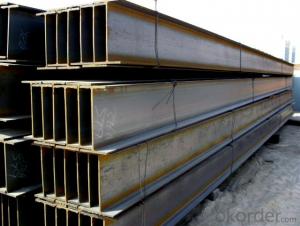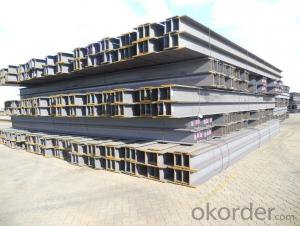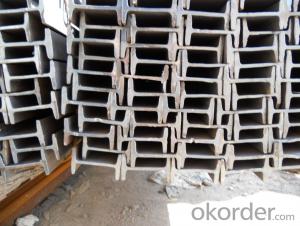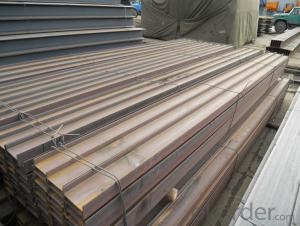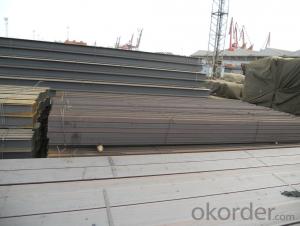Hot Rolled Mild Steel H Beams
- Loading Port:
- China Main Port
- Payment Terms:
- TT or LC
- Min Order Qty:
- 100 m.t.
- Supply Capability:
- 10000 m.t./month
OKorder Service Pledge
OKorder Financial Service
You Might Also Like
Product Description:
OKorder is offering Hot Rolled Mild Steel H Beams at great prices with worldwide shipping. Our supplier is a world-class manufacturer of steel, with our products utilized the world over. OKorder annually supplies products to African, South American and Asian markets. We provide quotations within 24 hours of receiving an inquiry and guarantee competitive prices.
Product Applications:
Hot Rolled Mild Steel H Beams are ideal for structural applications and are widely used inindustrial plants, civil construction, municipal works, oil platforms, bridges, flatbed beams, electrified railway power stand, railway bridges and other light steel structure, super-light H-beam is ideal for containers, mobile homes , all kinds of garage, box-type trains, electrical bracket, various venues, small villa manufacturing etc.
Product Advantages:
OKorder's Hot Rolled Mild Steel H Beams are durable, strong, and wide variety of sizes.
Main Product Features:
· Premium quality
· Prompt delivery & seaworthy packing (30 days after receiving deposit)
· Can be recycled and reused
· Mill test certification
· Professional Service
· Competitive pricing
Product Specifications:
Grade: SS400, Q235
Standard: JIS G3101, GB STANDARD
Payment: T/Tor L/C AT SIGHT
Technique: Hot Rolled
Package: Packed in bundles and shipped by break bulk or containers.
size | Kg/m |
100*100 | 16.9 |
125*125 | 23.6 |
150*75 | 14 |
150*150 | 31.1 |
148*100 | 20.7 |
198*99 | 17.8 |
200*100 | 20.9 |
248*124 | 25.1 |
250*125 | 29 |
FAQ:
Q1: How many tons of steel products could be loaded in containers?
A1: Usually the steel products are delivered by bulk vessel because of the large quantity and the freight. However, there are no bulk vessel enter some seaports so that we have to deliver the cargo by containers. The 6m steel product can be loaded in 20FT container, but the quantity is changed according to the size, usually from 18tons to 25tons.
Q2: what is the difference between actual weight and theoretical weight?
A2: All the section steel has two weights: actual weight and theoretical weight. Actual weight is the weighing out when the product delivered from the mill. Theoretical weight is calculated by pieces. The invoice can be based on each of them as your request.
Q3: How soon can we receive the product after purchase?
A3: Within three days of placing an order, we will arrange production. The normal sizes with the normal grade can be produced within one month. The specific shipping date is dependent upon international and government factors, the delivery to international main port about 45-60days.
Images:
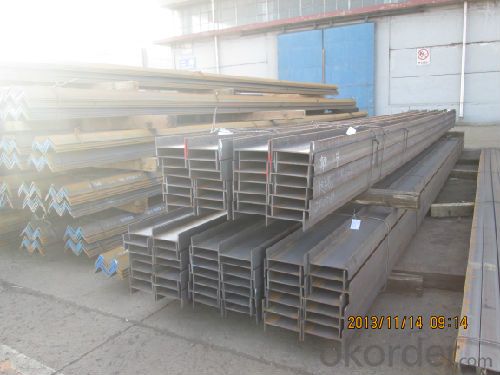
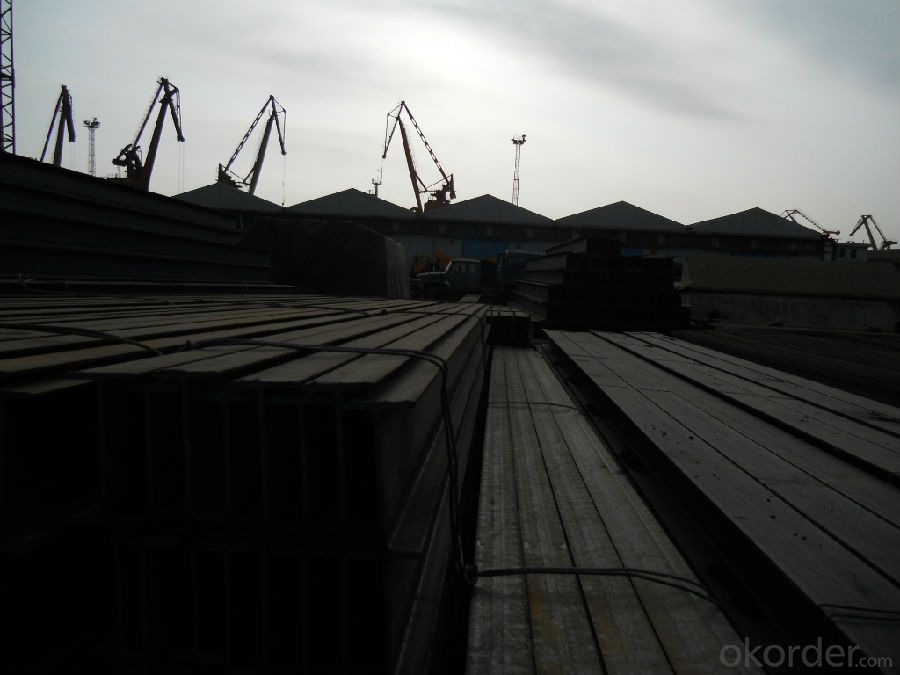
- Q:Can steel H-beams be used for transmission towers?
- Indeed, transmission towers can utilize steel H-beams. In the construction sector, steel H-beams find wide application, serving as support for bridges, buildings, and transmission towers. Their robustness and resilience render them ideal for bearing substantial loads and enduring severe weather. Moreover, the ease of fabricating and assembling steel H-beams contributes to their cost-effectiveness in constructing transmission towers.
- Q:Are steel H-beams resistant to extreme temperatures?
- Yes, steel H-beams are generally resistant to extreme temperatures. Steel is known for its excellent thermal conductivity and high melting point, which makes it highly resistant to heat. H-beams, specifically, are designed to support heavy loads and maintain their structural integrity even in challenging conditions. They are commonly used in construction projects where extreme temperatures, such as those experienced in industrial settings or in fire situations, may be present. However, it is important to note that prolonged exposure to extremely high temperatures can affect the strength and structural integrity of steel, so proper insulation and fireproofing measures should be considered in such cases.
- Q:Are Steel H-Beams resistant to UV radiation or fading?
- UV radiation and fading are not things that steel H-beams naturally resist. Carbon steel, the primary material used in constructing steel H-beams, lacks inherent UV resistance. When exposed to UV radiation over time, the steel can undergo oxidation, leading to rust formation and eventual material degradation. To safeguard steel H-beams from UV radiation and fading, manufacturers often use protective coatings like paint or galvanization. These coatings create a barrier between the steel and UV radiation, preventing direct contact and reducing the risk of fading or degradation. However, it's important to note that these protective coatings may require regular maintenance and reapplication to ensure long-term protection against UV radiation. Furthermore, external factors like climate, humidity levels, and the intensity of UV exposure can impact the rate at which steel H-beams fade or degrade due to UV radiation. Regular inspection and maintenance can help detect any signs of fading or degradation in steel H-beams, allowing for timely repairs or replacements to uphold their structural integrity.
- Q:What is the weight of a standard steel H-beam?
- The weight of a standard steel H-beam can vary depending on its dimensions and specifications. However, a typical standard steel H-beam weighs approximately 33 pounds per linear foot. It's important to note that the weight may differ for different sizes and grades of steel H-beams.
- Q:How do steel H-beams contribute to the overall sustainability of a construction project?
- There are several ways in which the overall sustainability of a construction project can be enhanced by the inclusion of steel H-beams. To begin with, steel is an exceedingly sustainable building material. It boasts a 100% recyclability rate, meaning that once a building reaches the end of its life, the steel beams can be melted down and repurposed for new construction endeavors. This practice helps to lessen the demand for raw materials and preserves our precious natural resources. Additionally, steel H-beams are renowned for their prolonged lifespan and minimal maintenance requirements. They possess exceptional durability and can withstand extreme weather conditions and heavy loads, thereby reducing the necessity for frequent repairs and replacements. Ultimately, this longevity results in reduced waste and a diminished environmental impact over time. Furthermore, steel H-beams offer considerable design flexibility, allowing for an efficient use of materials. Their high strength-to-weight ratio enables them to span longer distances, thereby facilitating the creation of more open spaces in buildings and reducing the need for additional support columns. This enhances the aesthetic appeal of the structure and maximizes the usable space, optimizing the building's energy efficiency and reducing overall material consumption. Moreover, steel is an energy-efficient material. It can be produced utilizing renewable energy sources, such as wind or solar power, thereby minimizing greenhouse gas emissions during the manufacturing process. Additionally, steel H-beams can be prefabricated off-site, reducing construction time and minimizing on-site energy consumption. Lastly, steel H-beams possess a high degree of fire resistance, which significantly contributes to the overall safety and resilience of a construction project. By withstanding high temperatures, they help prevent the spread of fire, thereby protecting both the building and its occupants. In conclusion, steel H-beams make a substantial contribution towards the overall sustainability of a construction project. Their recyclability, durability, energy efficiency, and fire resistance all serve to promote resource conservation, reduce waste, enhance structural integrity, and extend the lifespan of the building. Ultimately, this results in a minimized environmental impact and an improved overall sustainability of the construction project.
- Q:Can steel H-beams be used for supporting greenhouses or agricultural tunnels?
- Yes, steel H-beams can be used for supporting greenhouses or agricultural tunnels. Steel H-beams are known for their strength and durability, making them an ideal choice for supporting structures that require long spans and heavy loads. Greenhouses and agricultural tunnels often need to withstand the weight of the structure itself, as well as the weight of equipment, plants, and potential weather conditions such as snow loads or wind gusts. Steel H-beams provide the necessary strength and stability to support these structures, ensuring their longevity and safety. Additionally, steel is resistant to pests, rot, and decay, making it a suitable material for agricultural applications.
- Q:What are the common fire protection measures for steel H-beams?
- Common fire protection measures for steel H-beams include the application of fire-resistant coatings, the use of intumescent paints, and the installation of fire-resistant cladding. Fire-resistant coatings are often applied directly to the steel beams and are designed to withstand high temperatures, preventing the steel from reaching its critical temperature and losing its structural integrity. Intumescent paints are another option, which expand when exposed to heat, forming an insulating layer that slows down the transfer of heat to the steel beam. This helps to protect the steel from the effects of fire. Additionally, fire-resistant cladding can be installed around the steel H-beams, providing an additional layer of protection by insulating the steel from the heat and flames. These measures are essential to ensure the structural stability of steel H-beams during a fire and to prevent their failure.
- Q:What is the length of the butt joint of H steel? What is the minimum requirement?
- If the H type steel welding, to avoid flange and web seam in the same section, upper and lower flange splicing and splicing of webs staggered position should be more than 200 mm, flange splicing length should not be less than 2 times the width of the plate (this confused with steel butt not), web splicing width of not less than 300 mm. The length of not less than 600 mm.
- Q:What are the common design considerations for steel H-beams in roofing applications?
- There are several common design considerations for steel H-beams in roofing applications. These considerations are important to ensure the structural integrity and safety of the roof. 1. Load-bearing capacity: Steel H-beams need to be designed to withstand the weight of the roof, as well as any additional loads such as snow, wind, or equipment. The beams should be properly sized and spaced to distribute the loads evenly and prevent any potential for failure or collapse. 2. Span and support spacing: The span and support spacing of the steel H-beams should be carefully determined based on the specific roof design and anticipated loads. The beams need to be adequately supported to prevent excessive deflection, sagging, or bending. The spacing between the beams should be determined in accordance with engineering standards and codes. 3. Connection details: The connections between the steel H-beams and other structural elements, such as columns or purlins, should be carefully designed and executed. The connections need to be strong and secure to ensure proper load transfer and to prevent any potential for disconnection or failure. 4. Fire resistance: Steel H-beams used in roofing applications should be designed to provide adequate fire resistance. This can be achieved through the use of fire-resistant coatings, insulation materials, or by incorporating fire-rated materials into the design. 5. Corrosion protection: Steel H-beams are susceptible to corrosion, especially in outdoor roofing applications where they are exposed to the elements. Proper corrosion protection measures, such as galvanizing or using corrosion-resistant coatings, should be implemented to extend the lifespan of the beams and maintain their structural integrity. 6. Thermal expansion and contraction: Steel H-beams need to be designed to accommodate thermal expansion and contraction due to temperature variations. This can be achieved by incorporating expansion joints or allowing for appropriate clearance and movement in the design. 7. Sustainability considerations: In modern design, sustainability is a key consideration. The use of recycled steel or incorporating energy-efficient design elements can contribute to the overall sustainability of the roofing system. Overall, the design of steel H-beams in roofing applications should take into account load-bearing capacity, span and support spacing, connection details, fire resistance, corrosion protection, thermal expansion and contraction, and sustainability considerations. By addressing these design considerations, the steel H-beams can provide a safe and durable roofing solution.
- Q:Can steel H-beams be used in residential roof structures?
- Yes, steel H-beams can be used in residential roof structures. They are commonly used in construction due to their strength, durability, and ability to support heavy loads, making them suitable for various applications, including residential roofs.
1. Manufacturer Overview |
|
|---|---|
| Location | |
| Year Established | |
| Annual Output Value | |
| Main Markets | |
| Company Certifications | |
2. Manufacturer Certificates |
|
|---|---|
| a) Certification Name | |
| Range | |
| Reference | |
| Validity Period | |
3. Manufacturer Capability |
|
|---|---|
| a)Trade Capacity | |
| Nearest Port | |
| Export Percentage | |
| No.of Employees in Trade Department | |
| Language Spoken: | |
| b)Factory Information | |
| Factory Size: | |
| No. of Production Lines | |
| Contract Manufacturing | |
| Product Price Range | |
Send your message to us
Hot Rolled Mild Steel H Beams
- Loading Port:
- China Main Port
- Payment Terms:
- TT or LC
- Min Order Qty:
- 100 m.t.
- Supply Capability:
- 10000 m.t./month
OKorder Service Pledge
OKorder Financial Service
Similar products
New products
Hot products
Related keywords
